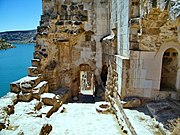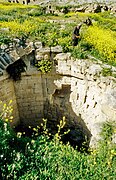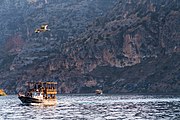Rumkale
| Rumkale | |
|---|---|
| Rumkale, Armenian Church in 1179 |
Rumkale (lit. 'Roman Castle';
History
Ancient History
Its strategic location was already known to the
Medieval History
In the late 11th century, the castle now known as Hromgla was part of the Armenian principalities of first

The castle became then part of the Armenian Kingdom of Cilicia. In the 1170 and 1172, theological conferences exploring a union of churches were held at Hromgla between the Armenian Church and the Byzantine Church with the Syrian Orthox (Jacobite) Church sending observers. In 1179, a synod of 33 Armenian bishops took place in Hromgla came up with a compromise and sent a profession of faith to Byzantine Emperor Manuel I Komnenos, but he died in September 1180 before it reached him.[9] From 1203 to 1293, it served as the residence of the Catholicos of the Armenian Church.[10] The site became an important center for manuscript production, reaching its artistic peak under the Catholicos Constantine I who employed Toros Roslin, whose stylistic and iconographic innovations had profound influence on subsequent generations of Armenian art.[8]
In 1292, it was captured by the Mamluks of Egypt following a protracted siege who then named it Qal'at al-Muslimin.
Access
The fortress, now situated across a peninsula created by the
Gallery
References
- ^ Sarafean, Georg Avedis (1957). A Briefer History of Aintab A Concise History of the Cultural, Religious, Educational, Political, Industrial and Commercial Life of the Armenians of Aintab. Boston: Union of the Armenians of Aintab. p. 27. Retrieved 4 September 2022.
- ISBN 9789757394235. Retrieved 18 November 2022.
- ^ Comfort, Abadie-Reynal & Ergeç 2000, p. 113.
- ^ "Roman Castle to open to tourism". Hürriyet Daily News. Retrieved 2020-03-28.
- ^ Dadoyan 2012, p. 41.
- ^ van Lint 1999, p. 32.
- ^ Russel 2005, p. 201.
- ^ a b Evans 2008, p. 141.
- ^ Hamilton 1999, pp. 4–5.
- ^ "Eastern Churches" by James Darling, London 1850, page 35, paragraph 2
Sources
- Comfort, Anthony; Abadie-Reynal, Catherine; Ergeç, Rifat (December 2000). "Crossing the Euphrates in antiquity: Zeugma seen from space". Anatolian Studies. 50: 99–126. doi:10.2307/3643016. Retrieved 27 February 2024.
- Dadoyan, Seta B. (1 November 2012). The Armenians in the Medieval Islamic World: Armenian Realpolitik in the Islamic World and Diverging Paradigmscase of Cilicia Eleventh to Fourteenth C. Transaction Publishers. ISBN 978-1-4128-4782-7. Retrieved 25 February 2024.
- Evans, Helen C. (2008). "Hromkla". Armenia - Art, Religion, and Trade in the Middle Ages. Metropolitan Museum of Art. ISBN 9781588396600. Retrieved 27 February 2024.
- Hamilton, B. (1999). "Aimery of Limoges and the Unity of Churches". In Ciggaar, Krijna Nelly; Teule, Herman G. B. (eds.). East and West in the Crusader States: Context, Contacts, Confrontations II : Acta of the Congress Held at Hernen Castle in May 1997. Peeters Publishers. pp. 1–12. ISBN 978-90-429-0786-7. Retrieved 26 February 2024.
- van Lint, Theo M. (1999). "Lament on Edessa by Nerses Snorhali". In Ciggaar, Krijna Nelly; Teule, Herman G. B. (eds.). East and West in the Crusader States: Context, Contacts, Confrontations II : Acta of the Congress Held at Hernen Castle in May 1997. Peeters Publishers. pp. 29–48. ISBN 978-90-429-0786-7. Retrieved 26 February 2024.
- Russel, James R. (2005). "The Credal Poem Hawatov Xostovanim ("I confess in faith") of St. Nerses the Graceful". In Ginkel, Jan J.; Murre-van den Berg, Hendrika Lena; Lint, Theo Maarten van (eds.). Redefining Christian Identity: Cultural Interaction in the Middle East Since the Rise of Islam. Peeters Publishers. pp. 185–236. ISBN 978-90-429-1418-6. Retrieved 26 February 2024.
- Stewart, Angus (2006), 'Hromgla', in Alan V. Murray (ed.), The Crusades: An Encyclopaedia, II, p. 607. ABC-CLIO, Inc., ISBN 1-57607-862-0
- ISBN 0-521-46226-6.







